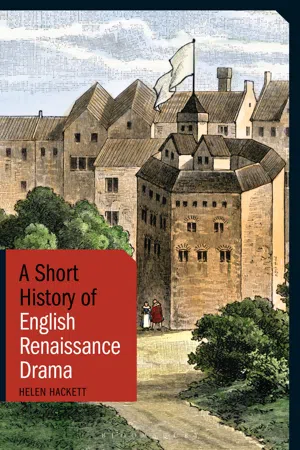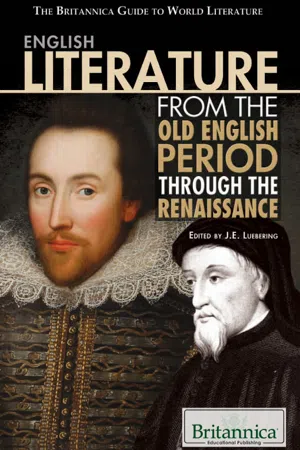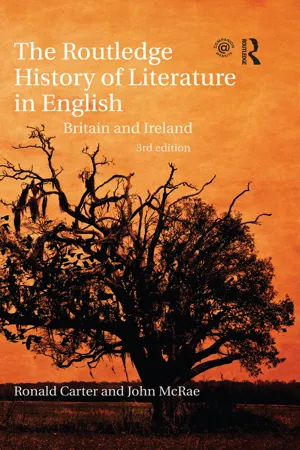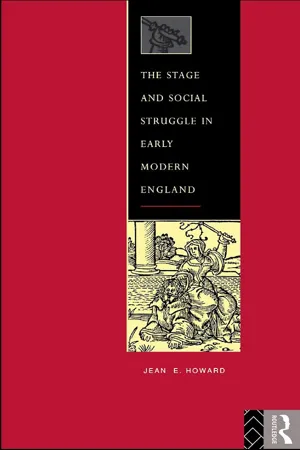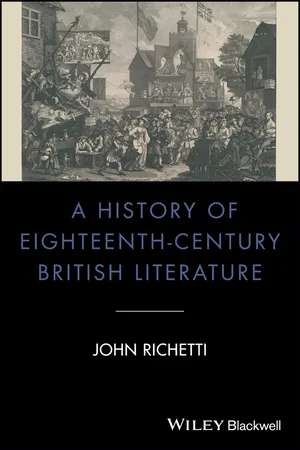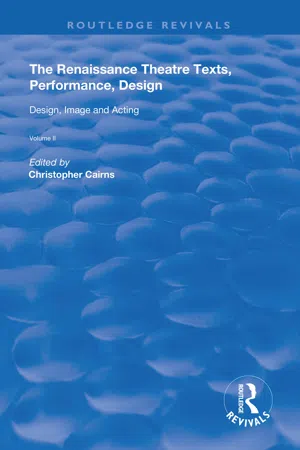Literature
English Renaissance Theatre
English Renaissance Theatre refers to the theatrical productions and performances that took place in England during the Renaissance period, roughly from the late 15th to the early 17th century. It was a time of significant growth and innovation in English drama, with the works of playwrights like William Shakespeare and Christopher Marlowe becoming iconic examples of the era's theatrical achievements. Theatrical forms such as tragedy, comedy, and history plays were popular during this time.
Written by Perlego with AI-assistance
Related key terms
8 Key excerpts on "English Renaissance Theatre"
- eBook - ePub
- Helen Hackett(Author)
- 2012(Publication Date)
- I.B. Tauris(Publisher)
c. 1585–1603) and the Jacobean period (1603–25) since these produced most of the Renaissance plays that are well known today. Its aims are threefold: to convey the variety and richness of English Renaissance drama; to explore why and how this period produced this creative explosion; and to suggest why these plays continue to have such hold upon readers and audiences in the modern world.WHAT WAS THE RENAISSANCE?At the outset it is worth pausing to consider what we mean by the term ‘Renaissance’. Literally it means ‘rebirth’, and the Oxford English Dictionary defines it as ‘the revival of the arts and high culture under the influence of classical models, which began in Italy in the fourteenth century and spread throughout most of Europe by the end of the sixteenth.’6 It took a little time for these developments to reach England, and therefore the English Renaissance is usually regarded as having taken place in the sixteenth and seventeenth centuries. In English drama, the period of greatest activity and artistic achievement was from the late 1580s to the 1620s, covering the last part of the Elizabethan period (Elizabeth I reigned from 1558 to 1603) and the Jacobean period (the reign of James I, 1603–25).Fifteenth-century Italy saw an artistic and intellectual flowering which many of its participants regarded self-consciously as a movement of renewal and of the rediscovery of the classical arts and scholarship that had fallen into decay in the middle ages. Classicism became associated with purity, naturalism, and clarity, as opposed to the supposed gothic barbarity of intervening centuries. This attitude was crystallized in the term rinascita , or rebirth, first used by the Italian artist and critic Giorgio Vasari (1511–74) in his book The Lives of the Artists (1550) to describe how Italian painters and sculptors of the fourteenth to sixteenth centuries had revived classical style and techniques. The general use of the term ‘Renaissance’ in cultural history began later, with The Civilization of the Renaissance in Italy (1860) by the Swiss author Jacob Burckhardt (1818–97). For Burckhardt the cultural advances of Italy in the fourteenth to sixteenth centuries were dependent upon the existence of competing independent city states ruled by despotic dynasties, who deployed artistic patronage as a means of celebrating and promoting their power. In this culture, despots and artists alike personified the triumph of the self-interested human will: ‘Despotism . . . fostered in the highest degree the individuality not only of the tyrant or condottiere himself, but also the men whom he protected or used as his tools.’ Burckhardt takes as an example Leon Battista Alberti (1404–72), an author, artist, and architect: ‘an iron will pervaded and sustained his whole personality; like all the great men of the Renaissance, he said, “Men can do all things if they will.”’ In his mastery of a wide and diverse range of intellectual interests Alberti also exemplified Burckhardt’s idea of the Renaissance man, ‘the “all-sided man” – l’uomo universale ’.7 - Britannica Educational Publishing, J.E. Luebering(Authors)
- 2010(Publication Date)
- Britannica Educational Publishing(Publisher)
CHAPTER 4
ELIZABETHAN AND EARLY STUART DRAMAI n the Elizabethan and early Stuart period, the theatre was the focal point of the age. Public life was shot through with theatricality—monarchs ruled with ostentatious pageantry, rank and status were defined in a rigid code of dress—while on the stages the tensions and contradictions working to change the nation were embodied and played out. More than any other form, the drama addressed itself to the total experience of its society. Playgoing was inexpensive, and the playhouse yards were thronged with apprentices, fishwives, labourers, and the like, but the same play that was performed to citizen spectators in the afternoon would often be restaged at court by night. The drama’s power to activate complex, multiple perspectives on a single issue or event resides in its sensitivity to the competing prejudices and sympathies of this diverse audience.Moreover, the theatre was fully responsive to the developing technical sophistication of nondramatic literature. In the hands of Shakespeare, the blank verse employed for translation by the earl of Surrey in the first half of the 16th century became a medium infinitely mobile between extremes of formality and intimacy, while prose encompassed both the control of Richard Hooker and the immediacy of Thomas Nashe. This was above all a spoken drama, glorying in the theatrical energies of language. And the stage was able to attract the most technically accomplished writers of its day because it offered, uniquely, a literary career with some realistic prospect of financial return. The decisive event was the opening of the Theatre, considered the first purpose-built London playhouse, in 1576, and during the next 70 years some 20 theatres more are known to have operated. The quantity and diversity of plays they commissioned are little short of astonishing.THEATRES IN LONDON AND THE PROVINCES
The London theatres were a meeting ground of humanism and popular taste. They inherited, on the one hand, a tradition of humanistic drama current at court, the universities, and the Inns of Court (collegiate institutions responsible for legal education). This tradition involved the revival of Classical plays and attempts to adapt Latin conventions to English, particularly to reproduce the type of tragedy, with its choruses, ghosts, and sententiously formal verse, associated with Seneca (10 tragedies by Seneca in English translation appeared in 1581). A fine example of the type is Gorboduc (1561), by Thomas Sackville and Thomas Norton, a tragedy based on British chronicle history that draws for Elizabeth’s benefit a grave political moral about irresponsible government. It is also the earliest known English play in blank verse. On the other hand, all the professional companies performing in London continued also to tour in the provinces, and the stage was never allowed to lose contact with its roots in country show, pastime, and festival. The simple moral scheme that pitted virtues against vices in the mid-Tudor interlude was never entirely submerged in more sophisticated drama, and the Vice, the tricksy villain of the morality play, survives, in infinitely more amusing and terrifying form, in Shakespeare’s Richard III (c- eBook - ePub
The Routledge History of Literature in English
Britain and Ireland
- Ronald Carter, John McRae(Authors)
- 2016(Publication Date)
- Routledge(Publisher)
The year 1588 had been the high point of Elizabeth’s reign. The defeat of the Spanish Armada signalled England’s supremacy of the seas. Shakespeare, beginning to write for the theatre around 1589, turns to the recent history of England in order to trace the human elements behind this conquest of power. From the three parts of Henry VI (1589–92) to the tragedy of Richard II (1595) and the historical pageant of Henry V (1599), Shakespeare examines the personalities who were the monarchs of England between 1377 and 1485. Generally called the history plays, these works are, on one level, a glorification of the nation and its past, but, on another level, they examine the qualities which make a man a hero, a leader, and a king. This is a process not of hero-worship, but of humanising the hero. The king is brought close to his people. His virtues and faults are brought to life before the audience’s eyes. Literature is no longer distant, no longer the preserve only of those who can read. It is familiar history enacted close to the real life of the people it concerns. All Renaissance drama, especially the works of Marlowe and Shakespeare, is profoundly concerned with shifting power relations within society. The individual was a new force in relation to the state. The threat of rebellion, of the overturning of established order, was forcefully brought home to the Elizabethan public by the revolt of the Earl of Essex, once the Queen’s favourite. The contemporary debate questioned the relationship between individual life, the power and authority of the state, and the establishing of moral absolutes. Where mediaeval drama was largely used as a means of showing God’s designs, drama in Renaissance England focuses on man, and becomes a way of exploring his weaknesses, depravities, flaws – and qualities. Henry VI is portrayed as weak, indecisive, in complete contrast to the heroic young Henry V - Jean E. Howard(Author)
- 2003(Publication Date)
- Routledge(Publisher)
Partly, as Catherine Belsey has argued (1985a:9–10), that is because dramatic narrative feeds on conflict and the postponement of resolution. Plays for the public stage were not, by and large, overtly homiletic, committed to the straightforward promulgation of dogma. Frequently composed by several hands and cobbling together a variety of discursive and narrative conventions, the drama often accommodated ideologically incompatible elements within a single text. Rather than as signs of aesthetic failure, these incompatibilities can be read as traces of ideological struggle, of differences within the sense-making machinery of culture. Moreover, theater involves more than scripts. It involves a particular scene of production, particular historically specific relations between audience and actor, playwright and theater owner. It will be one of the chief arguments of this book that in the English Renaissance the material practices attendant upon stage production and theatergoing had ideological consequences for the audience that were in some instances at odds with the ideological import of the dramatic fables which that theater disseminated. To show the role of the theater in social change means attending to just such contradictions.Moreover, as scholars of early modern drama have increasingly become aware, “Shakespeare” is not synonymous with Renaissance drama. He did not work extensively in some of the most vital dramatic genres of his time, such as city comedy, and his work encodes the ideologies of the aristocracy more centrally than do, for example, the plays of Dekker or Heywood. This book began as a study of Shakespeare; but it ended up as a consideration of plays by a number of other dramatists, as well, precisely because Shakespeare alone—despite the enormous reputation he has acquired in subsequent centuries—offers material for a very partial picture of Renaissance theater. In enlarging my scope beyond Shakespeare, however, I have not attempted to give anything like a history of the stage in this period. I pay almost no attention, for example, to the boy companies; do not try to trace the evolution of a single dramatic genre, despite a distinct partiality for histories and for comedy in all its forms; and do not attempt in any systematic way to map changes in the theater’s complex relations to the monarch and to state power in the decades between 1576 and 1642. Instead, I focus on clusters of texts in which the representation of the theater or of theatricality is a central issue and from this focus examine the ideological work performed by these texts in the venues in which they were first produced. Because my intent is to delineate what is distinctive about the theater’s role in ideological production in the period, I consider not only how dramatic spectacles and scripts differ from other contemporary forms of spectacle and of writing, but also how the early modern mode of theatrical production, as exemplified primarily in the large amphitheaters, involved material practices which themselves have ideological implications.- John Richetti(Author)
- 2017(Publication Date)
- Wiley-Blackwell(Publisher)
1 Johnson had very poor eyesight, and it is worth noting that his main emphasis on what happens in the theater is on “hearing” the lines in a play properly performed, on the techniques of dramatic oral rendition rather than the play’s moral or ideological content or the movement and spectacle on the stage. Acting in those years was clearly much more broadly histrionic than audiences will now tolerate, since large, expressive gestures and loud projection of the voice were essential in the large spaces of the main London theaters, lit only by candles and of course lacking amplification. And yet as Johnson’s comments make clear, audiences of the time, at least the more thoughtful members, were attuned to language and its proper and effective delivery. From the Restoration on, however, theatrical staging became quite elaborate with the introduction of moveable scenery, “machinery” as it was called then, along with music and dance, so that the language of the play, for tragedies often enough in rhymed couplets or more commonly in blank verse, shared the stage with the visual spectacle. In addition during the eighteenth century the play on offer (the main piece) was supplemented by an after‐piece, often a pantomime featuring spectacular stage effects and music and dancing.If we consider the main features of late seventeenth‐century tragedy and comedy, we can then ponder how the theater changed or developed (or degenerated) during the eighteenth century. Four popular Restoration “heroic” plays can serve as representative examples of the genre: Dryden’s two‐part The Conquest of Granada (1672), Nathaniel Lee’s The Rival Queens; or The Death of Alexander the Great (1677), Thomas Otway’s Venice Preserv’d (1682), and Thomas Southerne’s dramatic adaptation of Aphra Behn’s 1688 novella, Oroonoko (1695), the last three regularly staged throughout the eighteenth century (Oroonoko, for example, was performed over three hundred times until the early nineteenth century). To consider some typical samples of the varieties of Restoration comedy, I will look briefly at some features of a number of popular works: Dryden’s Marriage a‐la‐Mode (1673) and his Amphitryon (1690), William Wycherley’s (1640–1716) The Country Wife (1675), George Etherege’s (1636–92) The Man of Mode; or Sir Fopling Flutter (1676), John Vanbrugh’s (1664–1726) The Provok’d Wife (1697), and William Congreve’s (1670–1729) The Way of the World (1700).2 In my discussion of the Restoration stage, I will be mining the plays I have cited for styles and themes without claiming to offer anything like a complete description or analysis of any of them, since my effort is to trace the continuities and divergences in dramatic literature and performance in the eighteenth‐century English theater. It is also worth noting that many Restoration plays, comedies as well as tragedies, retained their popularity and were often revived during the eighteenth century. For example, Congreve’s masterpiece, The Way of the World- eBook - ePub
The Renaissance Theatre: Texts, Performance, Design
Volume II: Design, Image and Acting
- Christopher Cairns(Author)
- 2019(Publication Date)
- Routledge(Publisher)
The theatre appears as a shadow, as a context created by the interweaving of writings, discourses and figures and hypotheses about the function of discourse and the efficacy of knowledge. The theatrical word was the example of a discourse that recreates its context. The performance of the play created the context of a theatre comparable with the antique theatre in the modern city. In the eyes of the humanist Sabellico, Armonio, the Augustinian friar-humanist, in performing his play acted the presence of the Roman theatre in the cloister of a convent. At the root of the restoration of antique theatre lay the restoration of the context of ancient forms of acting, of their necessary and difficult relationship with oratory, poetry and philosophy, derived from those classical sources that looked to the theatre as to a special experience of communication. To restore the ancient forms of acting meant, for the humanists, to bridge the gap between rhetoric and theatre, between theatrical declamation and the intellectual’s public presence. They rediscovered, in the field of actio and of the composition of discourse, the complicity between effective persuasion and poetic emotion. On coming out of the schools, the humanist hypothesis encountered the places of Renaissance entertainment. In humanist performances those places became antique theatres, before being designed as theatres. Those places were the outer face of other premises that were, for the humanists, places of knowledge and of poetry. To perform in the antique manner, following the borderline between philosophers, poets and rhetoricians, and actors, meant for the humanists to perform theatre. The system of rhetoric as a discursive and persuasive technique has been identified by Marc Fumaroli 20 as one of the long-term characteristics of systems of knowledge that condition representational arts since the Renaissance - Donatella Fischer(Author)
- 2017(Publication Date)
- Routledge(Publisher)
4The actors replaced the authors as the central figures and prime creators in theatre production. Machiavelli and Ruzante are adduced not only for their own achievements but also as forerunners of a tradition of playwriting which, had it been allowed to flourish, might have compared in excellence and variety with that which emerged in Elizabethan England.Before dealing further with that question, it might be helpful to trace certain crucial developments in the early professional theatre of the two countries. The two proceeded independently but along largely parallel lines, although there can be no doubting the debt of English culture in general to Italian Humanism. It is no accident that many Elizabethan plays were set in Italy or were inspired by Italian tales, for England was in love with Italy and followed with keen interest the central developments of Renaissance style and thought. In some sectors, there was a certain delay before new trends embedded in Italian culture made their impact in England. For instance, the differing impact of the new cult of classical antiquity is apparent from a cursory examination of the dates of the first publication of Latin authors. The year 1470 saw the first publication of Terence in Italian, and c . 1480 the first edition of Seneca, but it was 1581 before Seneca His Tenne Tragedies was issued in English. The process by which the playwright emerged in his own right as a writer equal to the poet, historian, or philosopher can be compared to the emergence of the architect from the anonymous medieval mason. In both countries, the playwright aspired to a status equal to that of the poet as literary figure, and while it is true that Henry Medwall wrote in 1497 the first secular play in English to have come down to us, it was an isolated venture at that time, while Nicolò da Correggio’s Cefalo was performed at the court in Ferrara in 1487 and was the beginning of a tradition.5 The record of publication tells a different story. In 1515, Trissino published Sophonisba, while it was 1616 before Ben Jonson was able to publish his plays. Several more or less officially sanctioned versions of Shakespeare’s works appeared in his lifetime, but it was 1623, after the playwright’s death, before the First Folio was published. One year later, Francesco Andreini published in Italy the complete Bravure del Capitan Spaventa, although he had been publishing individual works piecemeal in the years following the death of his wife, Isabella, in 1604. Flaminio Scala published in 1611 his Teatro delle favole rappresentative,- eBook - ePub
Drama and the Theatre with Radio, Film and Television
An outline for the student
- John Russell Brown, John Russell Brown(Authors)
- 2023(Publication Date)
- Routledge(Publisher)
Most people seem to find something to interest them in the study of the past, even if their interest takes them no further than walking round historic buildings and stops short of actually reading history books. It is difficult to say just why there is this interest in the past, and, no doubt, the full explanation is complex and involves irrational motivation. One thing that could be said, however, is that the past sets standards. An achievement has to be remarkable for good or ill to survive all the destructive processes of time. In history is to be found the inspiration of great men’s lives, and warnings of man’s capacity for inhumanity to man. In the arts, history provides the achievements against which all later works of art must be measured. One can say, too, that history helps to explain the present. If one cannot know how it will all end, one can at least ask how it all began. I suppose this is the idea behind the journalistic phrase ‘the march of history’. Any one individual’s experience of time can be only the smallest sample. It is like an instantaneous photograph of a moving action which does not tell us how the action ended, or indeed even the direction of the movement. The study of history, even if it does not fully reveal the secret causes of the rise and fall of civilizations and of art movements, does at least free us from an experience limited to the present. One sometimes meets a prejudice against the study of history as being concerned with the dead past, and of no value to those who are interested in life here and now. History can, however, be a liberating force. It is easy to show how, in politics and in the arts, those who have changed the course of the future have drawn their ideas from the past. The Renaissance means the rebirth of classical culture. The Romantic Movement is also the Mediaeval Revival. One could also cite the influence of oriental drama on Brecht and Artaud. There is, of course, a more limited sense in which the study of the past helps us to understand the present. We have to live our lives in an environment which we have inherited, which contains many features the function of which is no longer clear. We still go to theatres where there is a dress circle in which no one is dressed up; where there are boxes from which one can see the audience better than the stage; and where the stage itself is surrounded by a gilded proscenium like a picture frame, from which, however, the picture has apparently been removed.The Interpretation of Classics
While it is the definition of a classic that it is not for an age but for all time, revealing meanings to later ages which were not apparent to contemporaries, the passage of time can expose it to misinterpretation. Like the varnish discoloured with age which alters the original colours of an old master, the change in language, in social custom and in theatrical conditions obscures the original quality of a play. The nineteenth-century scholars gave us excellent editions of the mediaeval miracle plays, but because they could not see beyond the realistic dramatic methods of their own time, they dismissed the mediaeval playwrights as unskilful. With the rise of perspective scenery in the seventeenth century, the stage-craft of Shakespeare was misunderstood, and for over two centuries his plays were never presented as he wrote them. If one is to be sure that one understands a classic, one must have regard to its historical context. A knowledge of the history of the theatre is almost essential if one is producing plays of the past. This is not to say that the modern production of a classic need be an archaeological reconstruction, though it is worth noting that some of the most successful of contemporary productions of classics have, in fact, incorporated features taken with little change from the original setting. What is necessary is that the present-day director should have some knowledge of the original principles of staging and of the original actor-audience relationship. He may then revive them or, as he will usually choose to do, find their modern equivalents. The alternative, chosen by some twentieth-century directors, of ignoring the original form and meaning of a classic seems to me to result in productions which are only of interest as experiments. They can never be finished artistic achievements because inevitably they involve clashes of style between the old and the new. In any case, they seem pointless. A classic is a sort of artistic oracle, and we do not consult the oracle to put words into its mouth.
Index pages curate the most relevant extracts from our library of academic textbooks. They’ve been created using an in-house natural language model (NLM), each adding context and meaning to key research topics.
